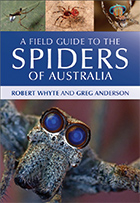A small Lycidas closely related to Maratus and sharing with Maratus the multicoloured iridescent upper surface of the abdomen and long third legs. It displays its abdomen and its third legs to a much less flamboyantly coloured female. Males of Maratus have the abdominal scute developed into side flaps that fold under the abdomen. In Lycidas there are no side flaps. In 1909 Eugene Simon described Habrocestum chrysomelas based on a single male that had been collected by Michaelsen and Hartmeyer on their expedition to south-western Australia in 1905. Julianne Waldock redescribed the species in 2002, finding it widespread throughout semi arid regions. Lycidas chrysomelas differs from other Lycidas species in males having a metallic dark green/peacock blue patch with 2 ovoid black sections on the upper surface of the abdomen. The female's cephalothorax is dark brown with pale yellow bands, the abdomen is yellow to creamy white, speckled with greyish markings. This species ranges from semi-tropical north-western Western Australia (Drysdale River Station) to mediterranean southern Australia, and east to Finley, New South Wales. The species name chrysomelas means mixed gold. ♀ 5mm ♂ 3.5mm
- Male, Western Australia
- Male, Western Australia
- Male, Western Australia
- Female, Western Australia
- Female, Western Australia
- Female, Western Australia
- Male, near Canberra
- Male, near Canberra
- Male, near Canberra
- References
Male, Western Australia

Male, Western Australia

Male, Western Australia

Female, Western Australia

Female, Western Australia

Female, Western Australia

Male, near Canberra

Male, near Canberra

Male, near Canberra

References
- Waldock, 2002 - Redescription of Lycidas chrysomelas Records of the Western Australian Museum 21: 227-234 (2002).

